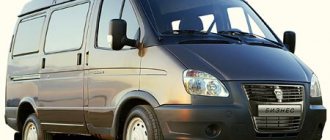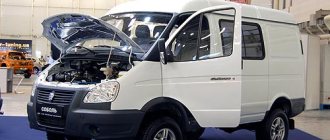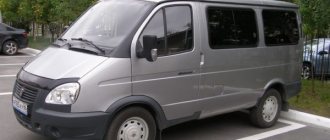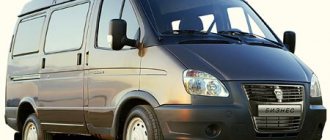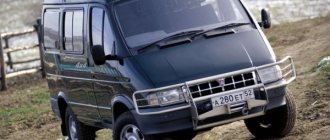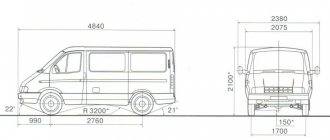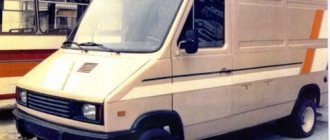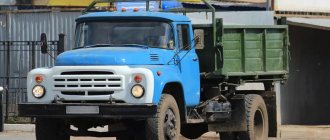“Sobol” is the general name of a series of vehicles for various purposes produced by GAZ since 1998. It includes the GAZ-2310 truck, the GAZ-2217 Barguzin minibus, the GAZ-2752 van and their modifications. For several years, the Sobol GAZ-2310 was produced in small series, in 2006 it was put on a conveyor belt shared with the GAZ 3302 cargo Gazelle - the number of vehicles immediately increased.
Van design Gas Sobol
The exterior of the Sobol is similar to the Gazelle; it can be distinguished by a base that is shortened by 140 mm, a shorter body length, and one wheel on each side of the rear axle (the Gazelle has dual wheels). There are differences in the design of some components that are not noticeable upon external inspection. The front suspension of the Sobol is independent, spring, on ball joints, the rear has lightweight springs installed for a lower load capacity.
The frame is made of new spars. The diameter of the front brake discs is larger than that of the Gazelle; at the rear there are drum-type brakes for single wheels. All variants of the Sobol are produced either with rear-wheel drive or with all-wheel drive (formula 4 x 2 or 4 x 4). The latter have an index with the number “7” at the end of the designation. After modification in 2010, the vehicles are equipped with UMZ-4216 gasoline engines or Cummins ISF 2.8 S3129T diesel engines.
Cummins ISF 2.8 S3129T engine ready for installation on Sobol.
Technical characteristics of UMZ-4216:
- Declared resource, thousand km - 250;
- Power, kW/l. With. - 78.5/107;
- Torque, N*m - 220;
- Gasoline brand - AI-93, AI-95;
- Fuel consumption per 100 km at speeds of 60/80 km/h, liters - 9.7/11.7.
Technical characteristics of Cummins ISF 2.8:
- Declared resource, thousand km - 500;
- Power, kW/l. With. - 88.3/120;
- Torque, N*m - 297;
- Fuel consumption per 100 km at a speed of 60/80 km/h, liters - 7.5/9.5.
In a car with all-wheel drive, fuel consumption for both engines increases by about one liter (per 100 km).
GAZ 2752 and its modifications
The all-metal van GAZ 2752 was adopted as the base model. With a carrying capacity of 0.9 tons, the vehicle has the right to drive even into the center of Moscow, where during the day a travel restriction is introduced for vehicles with a carrying capacity of over 1 ton. The maneuverability and compactness of the Sobol allows the mini-truck to freely penetrate tight yards, while the car is quite economical and comfortable.
Design and arrangement of passenger seats in the GAZ-2752
After 2003, the GAZ 2752 was restyled twice, and the latest modification, Sobol Business (since 2010), meets all modern requirements for this class of car in terms of equipment, comfort and ecology.
“Sable” 2752 has modifications in body type and wheel drive. According to the body type, the car can be a three-seater or a seven-seater van. In the 3-seater version, the total carrying capacity of the car is 0.75-0.9 tons, in the 7-seater version this figure is slightly less - 0.75-0.8 tons. Both modifications can be either rear-wheel drive or all-wheel drive. The all-wheel drive 4x4 model is called GAZ 27527, while the entire model range is equipped with different types of engines - both gasoline and diesel.
Overall dimensions of the car Sobol 2752
The luggage compartment is separated from the passengers by a solid partition; the luggage compartment doors are hinged - there are two of them, and they open to the sides almost 180° each.
Review of modifications of GAZ-2752 “Sobol”
GAZ-2752 “Sobol” is presented on the market in a cargo or cargo-passenger version. In the second case, there are seven full seats and a cargo compartment isolated from the passenger compartment.
The cargo, three-seater version of the GAZ-2752 van has a standard load capacity of 770 kilograms. The cargo compartment volume reaches 6.86 m3, its exact dimensions: 2,460/1,830/1,530 meters. Loading can be done either through the rear hinged doors or through the side sliding doors. The loading height of the cargo platform is only 70 centimeters.
The van can easily accommodate not only all kinds of boxes/packages with goods and tools; but also quite bulky items. Since the height of the luggage compartment is more than one and a half meters, and it is wider than the GAZel one (due to the fact that the Sobol has single-pitch wheels and the distance between the wheel arches is increased).
The combined cargo-passenger version of the GAZ-2752 “Sobol” has, in addition to the driver’s seat, six more seats for passengers, and has 3.7 m3 of usable space in the luggage compartment. The standard carrying capacity of the combi version of the GAZ-2752 is 305 kilograms. The dimensions of the cargo compartment are as follows: 1,330/1,830/1,530 meters. As already noted, the cabin in the cargo-passenger Sobol is separated from the cargo compartment by a solid partition, which has a positive effect on the comfort of passengers and their protection from cargo. It is possible to install a ceiling ventilation hatch in the passenger compartment.
In addition to rear-wheel drive, all-wheel drive all-metal Sobol vans are also produced (their factory index is GAZ-27527). The Sobol 4x4 is also available in three-seat cargo and seven-seat cargo-passenger versions, the features of which are described above.
What conclusions have we drawn?
The conclusions of our large test drive in Krasnodar are simple. GAZ-27527 “Sable” 4x4 appeared in a new guise, which, as it turned out, suits it quite well. The evolution of the Sobol from a minibus to an SUV took place on the assembly line of the Gorky Automobile Plant without any mutations. As for quality and related things, it’s very good that “Loaf” has a worthy competitor. After all, as you know, quality is born in competition. Now UAZ and GAZ, under favorable market conditions in the future, will be able to surprise us with new products in the future. Prices and equipment for the car can be found at the official GAZ dealer in Krasnodar.
Fuel consumption of GAZ-2752 • Pros of the car
The fuel consumption of the RT will be higher even if trips are made over short distances, and you often have to turn off, start and warm up the engine; In any seat, both passenger and driver, a person of even the most impressive, heroic build can freely and easily fit, and moreover, it will not be particularly convenient for a driver shorter than 170 centimeters to drive the GAZ-2217.
| Engine | Consumption (city) | Consumption (highway) | Flow (mixed) | Fuel type |
| 2.9 MT 107 hp (Mechanics) | 21,6 | 17,4 | 19 | Petrol |
| 2.8 MT 120 hp (Mechanics) | 19,9 | 14,8 | 17,5 | Diesel |
Specifications
| GAZ car model | 2310 | 23107 | 2752 | 27527 | 2217 | 22177 | 22171 | 221717 |
| Vehicle type | 4×2 | 4×4 | 4×2 | 4×4 | 4×2 | 4×4 | 4×2 | 4×4 |
| Total weight, kg | 2800 | 3000 | 2800 | 3000 | 2595 (2835)(1) | 2765 (3005)(1) | 2595 (2835)(1) | 2765 (3005)(1) |
| Weight of the equipped vehicle, kg | 1700 | 1920 | 1880 (1990)(2) | 2090 (2190)(2) | 2090 (2050)(1) | 2260 (2220)(1) | 2090 (2050)(1) | 2260 (2220)(1) |
| Axle load of a fully loaded vehicle, kg: | ||||||||
| front | 1250 | 1400 | 1260 (1405)(2) | 1410 (1525)(2) | 1250 (1310)(1) | 1360 (1420)(1) | 1250 (1310)(1) | 1360 (1420)(1) |
| rear | 1550 | 1600 | 1540 (1395)(2) | 1590 (1475)(2) | 1345 (1525)(1) | 1405 (1585)(1) | 1345 (1525)(1) | 1405 (1585)(1) |
| Base, mm | 2760 | 2760 | 2760 | 2760 | 2760 | 2760 | 2760 | 2760 |
| Overall dimensions, mm | ||||||||
| length | 4880 | 4880 | 4810 | 4810 | 4810 | 4810 | 4810 | 4810 |
| width | 2380 | 2380 | 2380 | 2380 | 2380 | 2380 | 2380 | 2380 |
| by mirrors | 2066 | 2066 | 2030 | 2030 | 2030 | 2030 | 2030 | 2030 |
| around the cabin | 2015 | 2015 | ||||||
| platform height (3) | 2070 | 2170 | 2200 | 2300 | 2100 | 2200 | 2200 | 2300 |
| height along the awning, mm | 2400 | 2500 |
- For buses with 10 passenger seats.
- For RVs with two rows of seats.
- For flatbed vehicles, the cabin height is indicated.
| GAZ car model | 2310 | 23107 | 2752 | 27527 | 2217 | 22177 | 22171 | 221717 |
| Front wheel track, mm | 1700 | 1720 | 1700 | 1720 | 1700 | 1720 | 1700 | 1720 |
| Rear wheel track, mm | 1700 | 1700 | 1700 | 1700 | 1700 | 1700 | 1700 | 1700 |
| Ground clearance (under the rear axle housing at full weight), mm | 205 | 205 | 205 | 205 | ||||
| Ground clearance (under the front suspension arms at full weight or under the front axle housing), mm | 150 | 205 | 150 | 205 | 150 | 205 | 150 | 205 |
| Minimum turning radius along the track of the outer front wheel, m | 5,5 | 6,0 | 5,5 | 6,0 | 5,5 | 6,0 | 5,5 | 6,0 |
| Fuel consumption (1) according to GOST 20306–90 when driving at a constant speed, l/100 km: | ||||||||
| 60 km/h | 10 | 11 | 10 | 11 | 10 | 11 | 10 | 11 |
| 80 km/h | 12 | 12,5 | 12 | 12,5 | 12 | 12,5 | 12 | 12,5 |
| Maximum vehicle speed on a horizontal section of a flat highway, km/h: | 135 | 130 | 135 | 130 | 135 | 130 | 135 | 130 |
| Overhang angles (with load), degrees: | ||||||||
| front | 22 | 28 | 22 | 28 | 22 | 28 | 22 | 28 |
| rear | 28 | 32 | 21 | 30 | 21 | 30 | 21 | 30 |
| Maximum incline overcome by a vehicle with a full load, % | 29 | 30 | 29 | 30 | 29 | 30 | 29 | 30 |
| Loading height, mm | 900 | 1000 | 720 | 820 |
- The given fuel consumption is used to determine the technical condition of the vehicles, is checked under conditions regulated by the relevant standards and is not an indicator of operational fuel consumption standards.
Engine
| Model | UMZ-42160 (Euro-3) | UMZ-42164 (Euro-4) |
| Type | 4-stroke, injection | |
| Number of cylinders and their location | 4, in-line | |
| Cylinder diameter and piston stroke, mm | 100×92 | |
| Cylinder displacement, l | 2,89 | |
| Compression ratio | 8,8 | 9,5 |
| Rated power, net kW (hp) | 78,5 (106,8) | |
| Maximum torque, net, daNm (kgf m) | 22,5 (220,5) | |
| at crankshaft rotation speed, rpm | 2500 | |
| Cylinder operating order | 1–2–4–3 | |
| Crankshaft rotation speed in idle mode, rpm: | ||
| – minimum (nmin. xx) | 800±50 | |
| – increased (npo. xx) | 3000±50 | |
| Direction of rotation of the crankshaft (observed from the fan side) | Right |
Transmission
| Clutch | Single disc, dry, hydraulically driven |
| Transmission | Mechanical, 5-speed with synchronizers in all gears Gear ratios: 1st gear – 4.05 2nd gear – 2.34 3rd gear – 1.395 4th gear – 1.0 5th gear – 0.849 Reverse – 3.51 |
| Transfer case for 4x4 vehicles | Mechanical, has two gears: high (i=1.07) and low (i=1.86), as well as a symmetrical center differential with forced locking |
| Cardan transmission | Two shafts with three universal joints and an intermediate support Three shafts (for 4x4 vehicles) with six universal joints |
| Front axle of 4×4 vehicles: | |
| main gear | Hypoid, gear ratio – 5.125 |
| differential | Bevel, gear |
| steering knuckles | With unequal velocity joints |
| Rear axle: | |
| main gear | Hypoid, gear ratio: 5.125 – for 4x4 vehicles; 4.3 – for 4×2 vehicles |
| differential | Bevel, gear axle shafts Fully balanced |
Chassis
| Wheels | Steel, stamped, disc, with one-piece rim 6Jx16H2 |
| Tires | Pneumatic, radial, chamber, size 225/60R16 or 215/65R16 - for auto. GAZ -2217 and mod. or 215/65R16, 185/75R16C (for GAZ-2310, GAZ-2752). Tire size for 4×4 vehicles – 225/75R16 |
| Suspension: | |
| front | Independent, on levers with coil springs, with anti-roll bar; shock absorbers - gas-filled, telescopic, double-acting (for 4x2 vehicles). |
| back | Two longitudinal semi-elliptical springs, with anti-roll bar, shock absorbers - gas-filled, telescopic, double-acting (for 4x2 vehicles) |
Steering
| Steering gear with power steering | Integral type, with screw ball nut transmission |
| Pump (power steering) | Lamellar, double action |
| Steering gear ratio (middle part) | 16,6 |
| Steering column | Adjustable in height and angle of inclination |
Brake control
| Service brake system | Double-circuit with hydraulic drive and vacuum booster |
| Brakes: | |
| front wheels | Disk |
| rear wheels | Drums |
| Spare brake systems | Each circuit of the service brake system |
| Parking brake system | With mechanical cable drive to the rear wheel brakes |
Electrical equipment
| Type of electrical equipment | Direct current, single wire. Negative terminals of power supplies and consumers are connected to the housing |
| Rated voltage, V | 12 |
| Generator: | 3282.3771000 |
| Starter: | 422.3708000 or 5732.3708000 |
| Additional starter relay | 711.3741–02 |
| Engine control system UMZ-4216 (E3): | |
| Control block | — Mikas М10.3 (4216.3763–82) – for 4×2 type vehicles (main pair i=4,3) — Mikas М10.3 (4216.3763–12) – for 4×4 type vehicles (main pair i=5,125) |
| throttle position sensor | 0 280 122 001 (form "BOSCH") |
| oxygen sensor | 25.368889 |
| phase sensor | 406.3847050–01 or DF-1 |
| timing sensor | 23.3847 or DS-1 |
| knock sensor | GT 305 |
| electromagnetic injectors | 0 280 150 560 (form "BOSCH"), ZMZ 9261DEKA 10 (form "SIEMENS") |
| idle air control | РХХ60 |
| dual ignition coil | 48.3705 or 5810.3705 |
| coolant temperature sensor control system | 234.3828 |
| Engine control system UMZ-4216 (E4): | |
| Control block | — Mikas 12.1 (42164.3763000) – for 4×2 type vehicles (main pair i=4,3) — Mikas 12.3 (42164.3763000–10) – for 4×4 type vehicles (main pair i=5,125) |
| nozzle | ZMZ6354 DEKA1D |
| dual ignition coil | 48.3705 or 5810.3705 |
| throttle pipe with electric drive | 40624.11481099 |
| gas pedal module | 6PV010033–00 (“Hуllс”) |
| Canister purge valve | 21103–1164200–02 or 1103–1164200–03 or 21103–1164200 |
| Submersible electric fuel pump module with fuel pressure regulator and level sensor | 7D5.883.046 "SEPO - ZEM", Saratov or E04.4100000–21 "AVTEL", Kaluga |
| Spark plug | WR15YC (brand "BRISK") or WR7BC (brand "BOSCH") |
| Oil pressure alarm sensor | 6012.3829 or MM 111V |
| Brake fluid level alarm sensor | YaM 2.553.000–01 or 10.3839000 or KDBA.406211.001 |
| Accumulator battery | 6ST-66LR |
| Headlights: | |
| right | 0301215 202 or 1512.3775000 |
| left | 0301215 201 or 1502.3775000 |
| Tail lights: | |
| for vehicles with platform | 171.3716 or 7702.3716 |
| for vehicles with all-metal body | 7202.3776 (right), 7212.3776 (left) |
| Wiper | 60.5205010 or 70.5205000 |
| Set of sound signals | 20.3721–01G/201.3721–01G |
Sable 4x4, UMZ-4216: average consumption 28l/100km
Good day! Don't kick too hard. In general, the problem is increased consumption. In our city, we have a problem with diagnostics; they can only read errors; when asked about the presence of a gas analyzer or a tester motor, they answer no, they haven’t heard. In general, here's the background: I bought the car in August. Sable 4x4 2011 tires stock engine UMZ 4216 Mikas 10.3 the car sat for half a year, I somehow started it and bought it, the price was attractive and the condition was excellent, mileage was only 53,000. I thought I’d take it and figure out the engine, but that wasn’t the case. I'm tired of figuring it out. When I drove the car, it didn’t move and was terribly stupid. First of all, as befits an ordinary teapot, I followed the path of least resistance, drove up to the final bus stop and found out where minibuses treat sores of the injection system. After listening to them carefully, I went to a local Gazelles diagnostics specialist, where I was successfully scammed out of 1,500 rubles. Having washed the injectors and condemned the pump, I, of course, rushed to the store for a new one. I changed one, another, then the injectors, then the PDZ sensor, wires, coils, then there were a couple more smart guys, after which I gave up on everything, having lost a lot of time, nerves and money (Loshar) and began to figure it out myself... I went and bought a fuel system pressure gauge and I connect the remote fuel pump directly to the battery, everything is OK, the pressure is 4, but when I connect it to the standard wiring, not only is the pressure 2, but it also starts pumping gasoline through the return line, I disassemble the module, it turns out that Plus and Minus are mixed up, I switch the contacts on the pump, pumped it up, and the FLS began to show the correct level of URA, but the pump does not have the pressure of the required 4 atm... I throw additional mass from the pump onto the body and lo and behold, the pressure returns to normal, I put the cool old gas pump on! Well, every cloud has a silver lining, there are still a couple of purchased fuel pumps left in reserve))) I’ve been driving for a couple of days, the acceleration dynamics are not bad, but I can’t get going normally, there are failures. We connect the SCANDOK failure to open the damper at 3-5%, what the hell is the sensor, it’s a new one... I buy another one from Bosch for food, it still doesn’t work, I still return it to the 1600 store. I've been driving like this for a month, I'm tired of going to Tula on the advice of a friend, we connect the diagnostics and after 5 minutes voila, they drive the car out with a smile on their face. I told him: - What's the problem? He told me: - The CO was screwed up, I set all the parameters from memory as they should be at XX rpm - 70, the main CO - 80. And indeed, the Gazelle is unrecognizable, it drove at low speeds, the dips disappeared as if by hand, and before that it stalled. On the way home, I feel that something is wrong, but it’s a long way back, I decided to give up, I’m tired, I think I’ll figure it out... I’ve been riding for a couple of weeks, the CHECK light comes on, I stop by for diagnostics, I ask you to just count the errors, I give you 200 rubles. I get the result - the error indicates a weak TPS signal))) and what do you think, when I go home I install the old original TPS sensor and the car is unrecognizable))) I’ve been driving for another month, I feel like I’m often stopping at a gas station. I buy a multitronics 580C on-board vehicle, I calibrate and calibrate the tank, I fill it to capacity, roll it with 25 liters, add 25.5 and now the consumption is 28 l/100 km at an average speed of 40 km/h. I’m sinning on Full Time, like the roll-up is bad, the transfer case is bad, I change the transfer case to Part-Time, I open the front axle, visually there’s no sound of metal in the oil, then I change the oil in all units to synthetic GL5 75W85 and do the wheel alignment, adjust the valves, measure the resistance on the explosives wires, changing the wheel bearings, and then winter has arrived, well, in general, I get a consumption of 31 liters... mixed cycle, and I also draw attention to the instantaneous consumption at idle, it is 2.3 l/hour. For comrades with identical cars, the consumption is 22-23 city at constant full. and 1.8 at XX.
Sable: description
Sable is also called “the king of wild furs” or “soft gold” because of its rather beautiful and very valuable fur. To date, scientists have been able to identify about 17 species of sables, which differ from each other in both size and coat color, as well as its quality. The Burguzin species is considered the most valuable, and it lives along the eastern coastline of Lake Baikal.
Interesting to know! The impenetrable taiga is home to a rather rare species - the white sable, which also represents the Mustelidae family.
The Burgusinian species is characterized by the presence of a bright black color in its coat, which is also soft and silky. The most light-colored subspecies, which have coarse and short hair, include:
- Sakhalin subspecies.
- Yenisei subspecies.
- Sayan subspecies.
Yakut sables have no less valuable fur, like the Kamchatka subspecies.
Appearance
Adults have a maximum body length of about half a meter, with a weight of 0.7 to 1.8 kilograms, and a tail length of about 20 centimeters. It should be noted that males are somewhat heavier than females.
The main colors of these animals are quite diverse and have their own names, like:
- “Head”, as the darkest, corresponds practically to black color.
- “Fur”, which is characterized by a lighter color, representing sandy yellow shades or fawn tones.
Interesting moment! The main colors depend both on the subspecies of the animal and the habitat.
It should also be noted that there are intermediate colors, including “collar”, which is distinguished by a very successful combination of brown shades, with a dark stripe running along the back in the form of a belt. In addition, such animals have a lighter color on the sides, and a lighter spot is located in the throat area. This predator has a pointed, wedge-shaped muzzle, triangular-shaped ears and rather small paws. The tail is relatively short, but it is covered with soft and fluffy fur. During colder periods, hair also grows on the paws, covering the pads and also the claws. Sables shed once a year.
Behavior and lifestyle
These predators are distributed throughout almost the entire taiga of Siberia, and they are quite strong and at the same time quite dexterous animals, despite their small size. This predator prefers to lead a terrestrial lifestyle, choosing for its habitat the upper reaches of mountain rivers with abundant thickets and stone placers. Often this animal can be seen in the crowns of trees. The movements of the predator are characterized as jumping, and the length of such jumps is on average half a meter. The fur of these animals quickly gets wet, so sables avoid water procedures.
Sable can be identified by the nature of the tracks left, which are characterized as paired with dimensions from 5x7 to 6x10 centimeters. The predator perfectly climbs any trees, and also has acute hearing and sense of smell. As for vision, it is not very developed, as well as voice data, which is more reminiscent of a cat's meow. These animals easily and quickly move through snow cover of any density. The animal is most active in the morning and evening hours.
Interesting fact! When the sable's nest is on the ground, in winter the animal digs a long tunnel in a layer of snow to provide itself with free entry and exit.
To rest, the predator uses various shelters, which it finds under fallen trees, in tree hollows located not high above ground level, and also under large stones. The resting place must be equipped, so the bottom is lined with dry ingredients such as moss, leaves, hay, feathers, etc. If the weather is bad, the sable tries not to leave its shelter, maintaining its temperature at 15-23 degrees. Not far from the nest, the animal arranges a toilet for itself. Every couple of years, the sable begins to look for a new nesting site.
How long does a sable live?
Living in the natural environment, this predator is able to live on average about 7 and a half years. This term depends on many negative factors, such as the presence of many deadly diseases, as well as many predators that also hunt sables. In captivity, the life expectancy of this predator doubles.
Sable - interesting facts
Natural habitats
Wild sables are found almost everywhere throughout the modern taiga, from the Urals to the Pacific coast, preferring colder northern regions characterized by the presence of forest vegetation. This predator inhabits dark coniferous or cluttered areas, preferring mature cedar trees.
Important point! This predator cannot be found in mountainous areas where there is no vegetation.
Sables are also found in Japan, and more precisely on the island of Hokkaido. Within the Eastern Urals there is a hybrid variety of sable called “kidus”. These are individuals that appeared as a result of crossing sable and marten.
What does it eat?
Sables are predators that prefer to look for food on the surface of the earth. As a rule, adult individuals find food for themselves much faster than young individuals. The basis of the sable diet is:
- Small animals such as voles, shrews, pikas, chipmunks, moles, squirrels, hares, etc.
- Various birds, such as wood grouse, hazel grouse, partridges, sparrows, as well as their eggs.
- Insects, including bees, as well as their larvae.
- Pine nuts.
- Various berries, such as rowan, blueberry, lingonberry, blueberry, bird cherry, currant, rose hip and cloudberry.
- Various plants, including wild rosemary.
- Bee Honey.
- All kinds of carrion.
Although sables do well in the canopy, they cannot jump from branch to branch as quickly as squirrels.
Natural enemies
Not a single bird of prey and not a single predatory animal hunts the sable purposefully, for the sake of food. Animals such as stoat and weasel are food competitors of the sable, so they often engage in fights for food items.
The most susceptible to attack are both young and old individuals who are not distinguished by the speed of their movements. If the animal is weak, it can be a source of food for any predator. Young sables are subject to attacks by many birds of prey, such as eagles, hawks, owls, etc.
Reproduction and offspring
This predator prefers to lead an isolated lifestyle, controlling an area of 150 to 2 thousand hectares. At the same time, sables actively protect their territory, not allowing the presence of strangers on their territory. The exception to the rule is the breeding season, when males engage in bloody fights for the right to own a female.
The breeding season of sables consists of a false rut, which is typical for the month of February/March, as well as a true rut, which occurs in June/July. During this period, females are busy searching for secluded places where they form their nests. The nest is carefully arranged and lined with dry moss, dry hay, and also with the hair of several eaten rodents. Nests may be in tree hollows or under the roots of large trees. The female carries her offspring for 9-10 months, which is a fairly long period for such a small animal.
It is important to know! Sables become sexually mature individuals in the 2nd or 3rd year of life. Reproductive age remains for 10 years, as evidenced by observations of individuals kept in captivity.
The female, as a rule, courageously defends her brood and can even attack a dog if it is not far from the nest. Some time after such an event, the female takes the cubs to another, safer place.
Each litter contains from 3 to 7 cubs, which are slightly more than 10 centimeters long and weigh about 30 grams, and they are also blind. About a month later they can already hear well, but they begin to see well a little later. Already at the age of one and a half months, the young begin to leave their nest, and in the month of August they already become completely independent and leave the female forever.
Transmission
| Clutch | Single disc, dry, hydraulically driven |
| Transmission | Mechanical, 5-speed with synchronizers in all gears Gear ratios: 1st gear – 4.05 2nd gear – 2.34 3rd gear – 1.395 4th gear – 1.0 5th gear – 0.849 Reverse – 3.51 |
| Transfer case for 4x4 vehicles | Mechanical, has two gears: high (i=1.07) and low (i=1.86), as well as a symmetrical center differential with forced locking |
| Cardan transmission | Two shafts with three universal joints and an intermediate support Three shafts (for 4x4 vehicles) with six universal joints |
| Front axle of 4×4 vehicles: | |
| main gear | Hypoid, gear ratio – 5.125 |
| differential | Bevel, gear |
| steering knuckles | With unequal velocity joints |
| Rear axle: | |
| main gear | Hypoid, gear ratio: 5.125 – for 4x4 vehicles; 4.3 – for 4×2 vehicles |
| differential | Bevel, gear axle shafts Fully balanced |
Interior
The modernization has significantly changed the interior of the new GAZ Sobol 4x4 2022 model year. In particular, the list of options now available even in the simplest version has noticeably increased, the ability to work with a multimedia system has appeared, and the quality of fabrics and plastics has noticeably improved.
Control and management bodies
The center console has become much more angular, and due to this its size has increased. In its center there is an insert on which there are four round air ducts, a modest display of the multimedia complex with physical buttons and washers along the edges, and just below there are control units for climate and off-road options. Also on the dashboard there were several compartments for things and connectors for connecting external storage media.
There is no tunnel as such, but in the place where it is usually located, we managed to place: a lever for operating the gearbox, a parking brake, a cup holder and a pocket for small items. The driver's seat can be equipped with a folding armrest.
The large-diameter steering wheel has a comfortable grip and boasts several buttons located on the side spokes. Immediately behind it, in the deep cavity of the dashboard, you can find a rather informative instrument panel with a dial tachometer and speedometer, as well as a small trip computer in the middle.
Seating
The cabin seats are well made, have lateral support, adjustments using mechanical drives and are even heated. The cabin will accommodate two- and three-seater sofas, as well as a single folding seat near the door. Despite the fact that there is no functionality here, and the seats themselves are not very comfortable on a long journey, they are separated by good-quality armrests and can be transformed into two very comfortable sleeping places.
Keeping at home
If you take a very small milk sable, you can make a pet out of it. He is easily tamed, he just needs to arrange an area for playing, for example, a balcony or a separate room with a net. It is necessary to purchase plastic toys; the animal is very active and will definitely need to be played with.
Gets along great with pets. Feed with meat waste, offal, cereal porridge, adding minerals and vitamins. You can give cat or dog food. The Institute of Cytology and Genetics is engaged in the domestication of the Altai sable, setting itself the goal of preserving the population and genetic diversity of this species.
They compiled a genetic map that included all the varieties distributed throughout Russia, with topological marks of populated areas.
Domesticated sables are being introduced into pockets of wild representatives of the breed, into places uninhabited by people. This brings results in increasing the number of animals.
GAZ presented two prototypes of the Sobol Next 4×4 Pros of the car
| Gazelle Sobol fuel consumption per 100 km – Sobol fuel consumption per 100 km gas. Characteristics of GAZ (GAZ) 2217 Sobol 22177 2. 5 4WD 4 doors. minibus 5 manual transmission 2006- TeploEnergoRemont Onboard A21R22 short wheelbase A21R32 long wheelbase Overall dimensions Length, width, height, mm 5630x2068x2137 6709x2068x2137 Wheelbase, mm 3145 3745 Ground clearance, mm 170 170 Number Front track, mm 1750 1750 Rear track, mm 1560 1560 Turning radius by tires, m 5.6 6.5 Trunk volume, l n d n d Weight Curb weight MT AMT, kg 2060 2230 Load capacity MT AMT, kg 1440 1270 Engine Engine type 4-cylinder turbodiesel 4-cylinder turbodiesel Maximum power, l. However, many owners of commercial vehicles switch their cars to gas despite all the disadvantages of gas fuel; installing LPG is justified, but provided that the Gazelle is used constantly. |
| GAZ-27527 Sable 4x4 technical characteristics and user reviews, engines and fuel consumption In 2003, the company carried out a planned restyling, during which Barguzin not only changed in appearance, but also received technologically advanced power plants. With the introduction of body glazing and the subsequent addition of passenger seats, the car acquires the ability to simultaneously transport up to 10 people. |
Features • The maximum permissible vehicle speed is 120 km/h.
Maintenance on farms
It is good to conduct the initial stage of creating a farm with a person who has experience in this matter. Choose an area near the forest, protected from the wind, flat, without strong changes in terrain. Equip a fence to
| Before setting up a sable breeding business, you should consult with a lawyer, because the rules provide for the sale of pelts only to state-owned enterprises. If an unknowing breeder sells fur to a private person, this will be a violation of the law. |
prevent wild animals from entering yards. Provide electricity, sewerage, water. The breeder arranges separate enclosures or cages for separate keeping of females and males. In the cage or house there is a separate room for a hole in which the puppies will be located. During the rut, the animals are kept together and their behavior is observed - individuals that do not want to mate are discarded and go to pelts in the fall.
The animals are purchased from farms a couple of months before the rut and seated in pairs, observing the boys’ ability to rut. The selected varietal individuals are marked, assigning a number to each and placed on the farm to produce offspring. Females are given even numbers and odd numbers for males, as is customary in fur farming.
The most promising producers are given a passport, preserving their pedigree up to the third generation. The grown young animals are placed in separate cages. To obtain high quality fur, they are well fed with offal, rabbit meat, chicken meat, and beef. Add berries, fruits, cereals.
Due to the high demand for sable fur, well-equipped farms bring high income to their owners. To begin with, it is enough to have 50 animals and set up a farm in your dacha, which will reduce rental costs.
The approximate price of a live animal is 200-500 dollars. The first year will only be expenses, but with proper care, the livestock will triple within a year. By the end of the second year, the skins are slaughtered and sold.
It is recommended to sell through a fur distribution company. State farms sometimes disperse animals into their habitats to maintain the population. This helps protect animals from extermination.
Basic data for adjustments and control
| Oil pressure, kPa (kgf/cm2) on a warm engine at idle speed: | 127 (1,3) |
| Gap between rocker arms and valves on a cold engine at 15–20° C, mm | |
| – for exhaust valves of cylinders 1 and 4 | 127 (1,3) |
| – for other valves | 0,35–04 |
| Normal liquid temperature in the cooling system, °C | 80–105 |
| Minimum crankshaft rotation speed in idle mode, rpm: | 800–850 |
| Gap between spark plug electrodes, mm | 0,7–0,85 |
| Fan belt deflection when pressed with a force of 4 daN (4 kgf), mm | 7–9 |
| Deflection of the water pump and generator belt when pressed with a force of 4 daN (4 kgf), mm | 8–10 |
| Deflection of the power steering pump belt when pressed with a force of 4 daN (4 kgf), mm | 6–10 |
| Clutch pedal free play, mm | 7–15 |
| Clutch slave cylinder rod stroke | 18–20,5 |
| Free travel of the brake pedal when the engine is not running (1), mm | 3–5 |
| Total steering wheel play,° | According to GOST R 51709–2001 |
| Minimum permissible friction layer thickness, mm: | |
| – front disc brake pads | 3,0 |
| – rear drum brake linings | 1,0 |
| The slope at which a vehicle with a full load is held by the parking brake is not less than, % | 16 |
| Installation of (2) front wheels: | |
| – caster (longitudinal inclination of the steering axis of the wheels) | +4°30’±1° (+3°±1°) (3) |
| – difference in the angles of the left and right wheels when adjusting caster, no more | 0°30′ |
| – wheel camber | 0°30’±30′ (+1°±30′) (3) |
| – difference in the angles of the left and right wheels when adjusting the camber, no more | 0°30′ |
| – wheel toe-in (each wheel to the longitudinal axis of the vehicle) | from +0°03′ to +0°10′ (from+0°01'to +0°08′) (3) |
| Installation angles (4) of the front wheels: | |
| – camber (5) | 1o |
| – lateral inclination of the kingpin | 8o |
| – longitudinal inclination of the kingpin | 4o |
| – wheel toe-in, mm | 0–3 |
| Air pressure in tires of 4×2 type vehicles, kPa (kgf/cm2): | |
| – front wheels | 260+10 (2.7+0.1) – for auto. GAZ-2217 and mod. 320+10 (3.3+0.1) – for GAZ-2310, GAZ-2752 with tires 185/75 R16C 250+10 (2.6+0.1) – for GAZ-2310, GAZ-2752 with tires 215/65 R15 |
| – rear wheels | 270+10 (2.8+0.1) – for auto. GAZ-2217 and mod. for 6 passenger seats 300+10 (3.1+0.1) – for cars. GAZ-2217 and mod. For 10 passenger seats 380+10 (3.9+0.1) – for GAZ-2310, GAZ-2752 with tires 185/75 R16C 290+10 (3.0+0.1) – for GAZ-2310, GAZ -2752 with 215/65 R16 tires |
| Air pressure in tires of 4×4 type vehicles, kPa (kgf/cm2): | |
| – front wheels | 240+10 (2,5+0,1) |
| – rear wheels | 240+10 (2,5+0,1) |
Body
The body is all-metal, half-hood, has two hinged cabin doors, a sliding side door and two hinged rear doors (for vehicles with a medium roof) or one rear door that opens upward (for vehicles with a low roof).
| bus cabin | Double or triple |
| RV cabin | Three or seven seater |
| overall dimensions (internal) of the cargo compartment of the van, mm: | |
| length | 2460/1330(2) |
| width | 1830 |
| height | 1430/1530(3) |
| volume of the cargo compartment of the van, m3 | 6,4/3,4 (2) |
- For vehicles with an all-metal body.
- For auto GAZ-2752 and mod. with two rows of seats.
- For body with medium roof.
Appearance
The photo clearly shows that the design of the car has undergone significant changes from all sides. The new body now looks very menacing and is in no way inferior to many European cars of this class, which is good news.
The front of the car is especially impressive. As before, it takes up very little space and is located at a significant slope to the road. At the very top you can see a huge rectangular windshield, which provides excellent visibility to the driver. The hood lid can boast of its embossed surface. The central part of the bumper turned out to be incredibly aggressive. Along the perimeter it is trimmed with a thick strip of unpainted plastic. The same material is also used to separate the main air intake system into several parts. The headlights have greatly changed their appearance. They are now rectangular and located at a large angle.
The lower part of the bumper boasts plastic reinforcement to make the car easier to drive on rough terrain and off-road. There are also special small recesses in which anti-fog optics are placed. The Barguzin version boasts several hooks for towing a car or other vehicle. They are hidden under the plastic, as well as under the license plate.
The profile part of the car acquired a rectangular shape, and also got rid of all the annoying sliding doors. Now you can get into the salon using a small door that occupies approximately one third of the entire body area. The massive windows, decorated with narrow black frames, also received a rectangular shape. The mirrors, trimmed with unpainted plastic, have increased in size. In the center you can find a lot of stepped relief, and below the car is decorated with wide arches with plastic lining and turn signals above the front wheels.
The rear of the car has a square shape. As before, there are a pair of doors here that open in different directions. They are also complemented by square windows with a black frame, a plastic handle, a small amount of relief and a platform for a license plate. The perimeter of the body is finished with plastic. The side lights are located on the side pillars, and the fog lights are located on the body kit below.
Lifestyle and habitat
From the Urals, along the Yenisei, throughout Siberia to the Pacific Ocean, different species of forest sable . You can see it in Mongolia, North Korea, and in some areas of China. Until the nineteenth century, it was found in Karelia, the Baltic states, Finland, and western Poland. Massive demand for valuable skins has led to the destruction of many forests.
Some forests have lost their entire population, it has practically disappeared. By the nineteenth century, fur exports accounted for the lion's share of government revenue. 1916 - 20-30 sables remained, which led to a ban on all types of extraction of valuable skins.
The beginning of the twentieth century - expeditions were sent to Siberia and Kamchatka to study the area and the conditions for creating a reserve to preserve the population of the unique Barguzin sable. History has preserved them as “sable expeditions”.
The enterprise was headed by G.G. Doppelmair, the scientists worked simply in the open air, the conditions were extremely difficult. The defined boundaries of the reserve, covering an area of 500,000 hectares on the slopes of the Barguzinsky ridge, are still the core of the protected area. At the turn of the century and revolutionary history, the ascetics carried out tremendous work, the fruits of which we are reaping to this day.
The Barguzin Biosphere Reserve, where sables are protected under the Endangered Species Act, is an absolute natural reserve - a model of nature. The anthropogenic impact on the territory is minimal. The sable lives freely and develops safely, being safe.
Now they hunt him with a photo gun, issuing a pass to visit the reserve. The territory of the reserve is intended for scientific biological and zoological research. Scientists of the Academy of Sciences comprehensively study the habits and biological cycles of the animal and give recommendations for the proper conservation of the species.
The sable is considered a terrestrial animal, although, as an inhabitant of the taiga, the animal is an excellent tree climber. It covers distances of up to four kilometers per day, and dry years force it to run up to 10 km in search of food.
Mainly settles in coniferous forests: pine, cedar, spruce forests. The hollows of fallen trees are perfect for predators to make holes in to overwinter and breed their offspring.
They arrange it carefully, covering it with moss and dry leaves, and keep the toilet away from the nest. He marks his territory around himself, laying personal paths so that no strangers hunt in his domain. Rocky places are also places where animals live.
Wheel pressure on sable
Vehicles of the Sobol family are passenger, utility and cargo vehicles. GAZ-2217 (bus)
GAZ-2752 (van)
GAZ-2310 (with flatbed)
Air pressure in tires, kPa (kgf/cm2)
front wheels: seven-seater bus – 260+10 (2.7+0.1) eleven-seater bus – 260+10 (2.7+0.1) GAZ-2310 and GAZ-2752 – 320+10 (3.3+0 ,1)
rear wheels: seven-seater bus – 270+10 (2.8+0.1) eleven-seater bus – 300+10 (3.1+0.1) GAZ-2310 and GAZ-2752 – 380+10 (3.9+0 ,1)
Please tell me what pressure to pump into the tires of the all-wheel drive SOBOL?
Modifications
GAZ-2310 is a chassis on which an on-board platform is installed, complete with a removable awning. It is possible to install a manufactured goods or specialized van. The model is not subject to road signs that impose restrictions on trucks.
Layout and dimensions of the on-board Sable
To drive, it is enough to have a license with an open category “B”. The internal dimensions of the platform are 2330 x 1980 x 1565 mm (height along the awning).
Salon
Fans of the car also received a noticeable improvement in the interior. The new GAZ Sobol Next 4x4 2022 model year now has a completely stylish and comfortable interior, which boasts all the most necessary modern options. Of course, only inexpensive materials such as fabrics and plastic are used for interior decoration, but their quality has noticeably improved, and numerous extraneous sounds made by interior elements while driving have disappeared.
The center console here is quite large and has a rectangular shape. All the most important things are in the middle. The main elements include the large display of the multimedia installation, which is controlled using several buttons located on the sides of the monitor. Below there is a small panel that includes switches for activating off-road options, and it all ends with heater and air conditioning control washers. On the sides of this entire structure there are four round deflectors. Like most vans, some elements of the tunnel are located on the dashboard. Here you can find a gear shift knob, various organizers and even one cup holder that is hidden in the dashboard. At the standard place of the tunnel there is only the parking brake handle.
A total of eight people can be in the car at the same time. Quite comfortable seats have been prepared for each of them, which boast good fabric finishing and soft filling. Those people who are located in the front can adjust their seats forward or backward using mechanical drives, as well as activate heating in cold weather. The salon has a pair of sofas designed for two and three people. Another place is located near the front door and can be removed as unnecessary. These seats are equipped with nothing other than seat belts and folding armrests in the center, but they can be folded out into an almost flat single sofa. There is also a lot of space left here for storing some things. The car doesn't even need a test drive to understand that it's great for traveling.
Population and species status
Even in the century before last, sables could be found in vast territories, from the Pacific coast to Scandinavia. Currently, such fur-bearing animals are practically not found in many European countries. This is due to very intensive fishing in the last century, which caused a significant decline in their numbers, as well as a reduction in their habitat. As a result of such a thoughtless and massive extermination of such animals, they received the status of “on the verge of extinction.”
In order to preserve the total number of wild fur-bearing animals, some conservation measures were developed and implemented related to the artificial breeding of such animals in nature reserves with their subsequent resettlement in their natural habitat. As a result of such measures, it was possible to partially stop the process of population decline. For example, in the Troitsko-Pechersk region their numbers are such that they do not cause any particular concern. The same can be said about many other regions of our country. In 1970, the number of individuals was only 200 thousand, which was the reason for these animals being included in the International Red Book.
Interesting to know! Over the past half century, sables have successfully populated an 80-kilometer strip of dark coniferous forests that border the Ural Range, so this animal is hunted in sufficient quantities, despite the lack of government economic support.
In order to optimize the process of catching this predator, a decision was made to reorient hunters to self-catching methods. This approach makes it possible to control production volumes quite effectively, preventing mass uncontrolled destruction of individuals.
It is equally important to regulate the number of animals during non-migration seasons in order to preserve valuable fur-bearing animals on hunting grounds.
